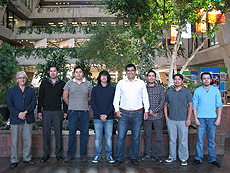Students benefit from Fermilab-Latin American collaboration
 |
Students currently in MINERvA's Latin American collaboration come from Brazil, Chile, Mexico and Peru to study at Fermilab. From left: collaboration founder Jorge Morfin (Fermilab), Edgar Valencia, Aaron Higuera (both at U. Guanajato, Mexico), Gonzalo Diaz (PUCP, Lima, Peru), Leo Aliaga (College of William and Mary, Virginia, U.S.), Arturo Fiorentini, Kenyi Hurtado, David Martinez (all three at CBPF, Rio de Janeiro, Brazil). Photo: Jessica Orwig
|
Students in Latin America do not typically have access to facilities where they can practice experimental particle physics first-hand. However, Fermilab provides an opportunity for Latin American students to gain experience in experimental physics through the MINERvA experiment.
Former MINERvA co-spokesperson Jorge Morfin initiated the collaboration with Latin American institutions in 2005 when MINERvA was still in its early days of construction. Since then, nearly 30 Latin American physics students from five universities in four Latin American countries, Brazil, Chile, Mexico, and Peru, have come through the program.
Professors in the four Latin American countries, who are part of the MINERvA collaboration, send students to study and work at Fermilab. The students' contributions have helped the project as much as the opportunity has helped them work toward their master's and doctoral degrees in physics.
"MINERvA wouldn't be as successful as it is today without the help of these excellent students," Morfin said. "The students realize this is their chance to get hands-on experience and so they work extremely hard."
Currently, nine Latin American students from the collaboration are conducting research at Fermilab, which involves everything from the MINERvA detector's hardware to data analysis to theory.
"MINERvA's a very small experiment, so these students have gotten the rare opportunity to see a large part of what makes a physics analysis," said Debbie Harris, current MINERvA co-spokesperson. "They have to learn how to calibrate the detector, take the data and replace something if it breaks."
In addition to learning the science, the students also have to become fluent in English. In fact, Morfin holds weekly meetings where all the students get together and one or two present their scientific progress in English. Harris and Morfin agree that seeing the students grow more confident in their mastery of the physics and their English speaking skills so they can competently present their work is one of the most rewarding parts of the program.
A handful of students who have worked on MINERvA for their master's degrees have come back for another round to conduct research for their doctorates. One such student, Aaron Higuera from University of Guanajuato, Mexico, has been working with MINERvA since 2008.
"Fermilab is one of the world's leading laboratories in particle physics, and it is an amazing experience to be part of that," Higuera said. "I really enjoy studying neutrino physics and I hope to continue studying neutrinos in the future."
The program has been a great success in Latin America, Morfin said. He is now looking to expand opportunities to students in other countries. In fact, the program recently accepted its first student from Madagascar, Laza Rakotondravohitra, who arrived at Fermilab in August.
—Jessica Orwig
|